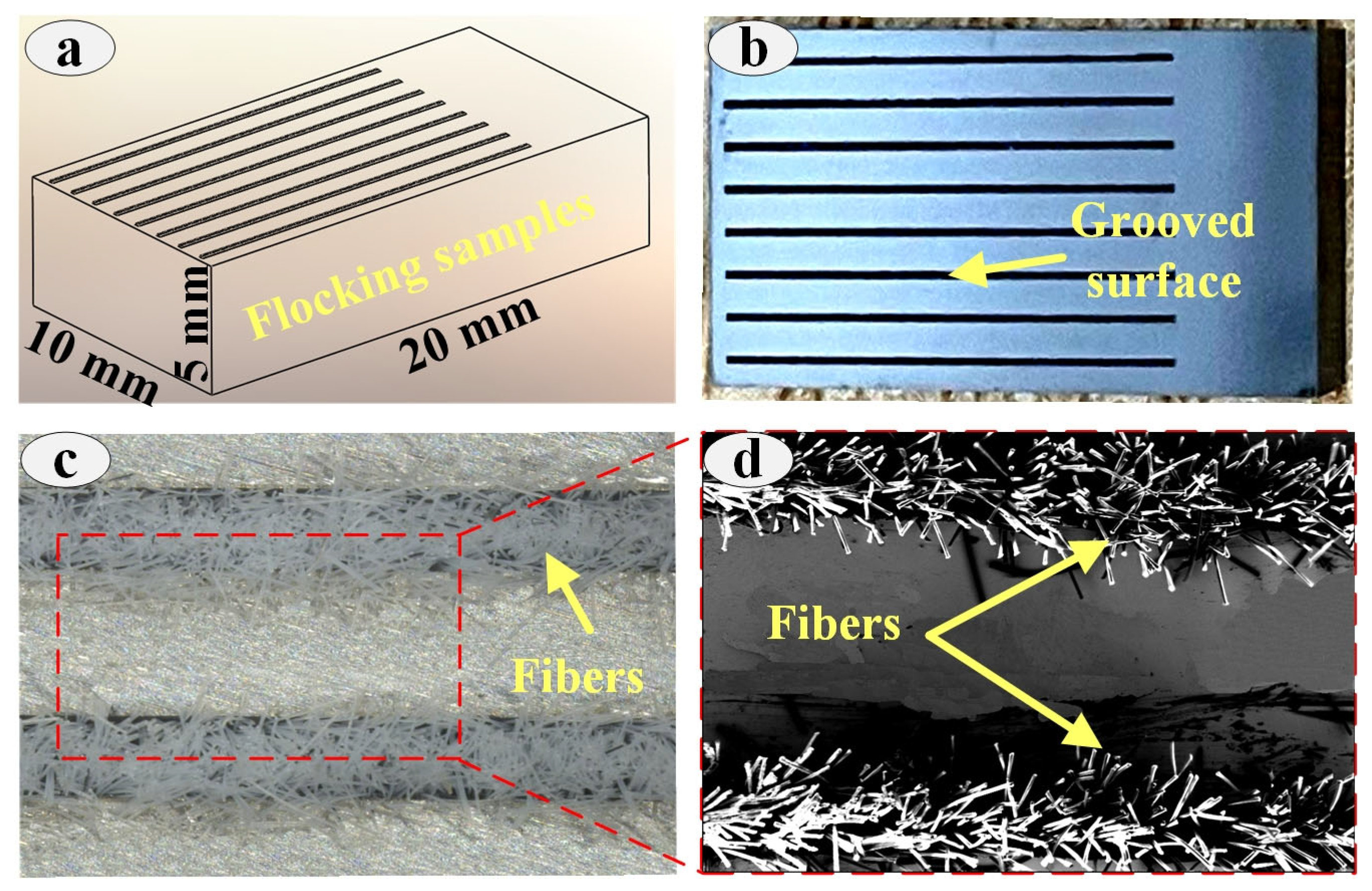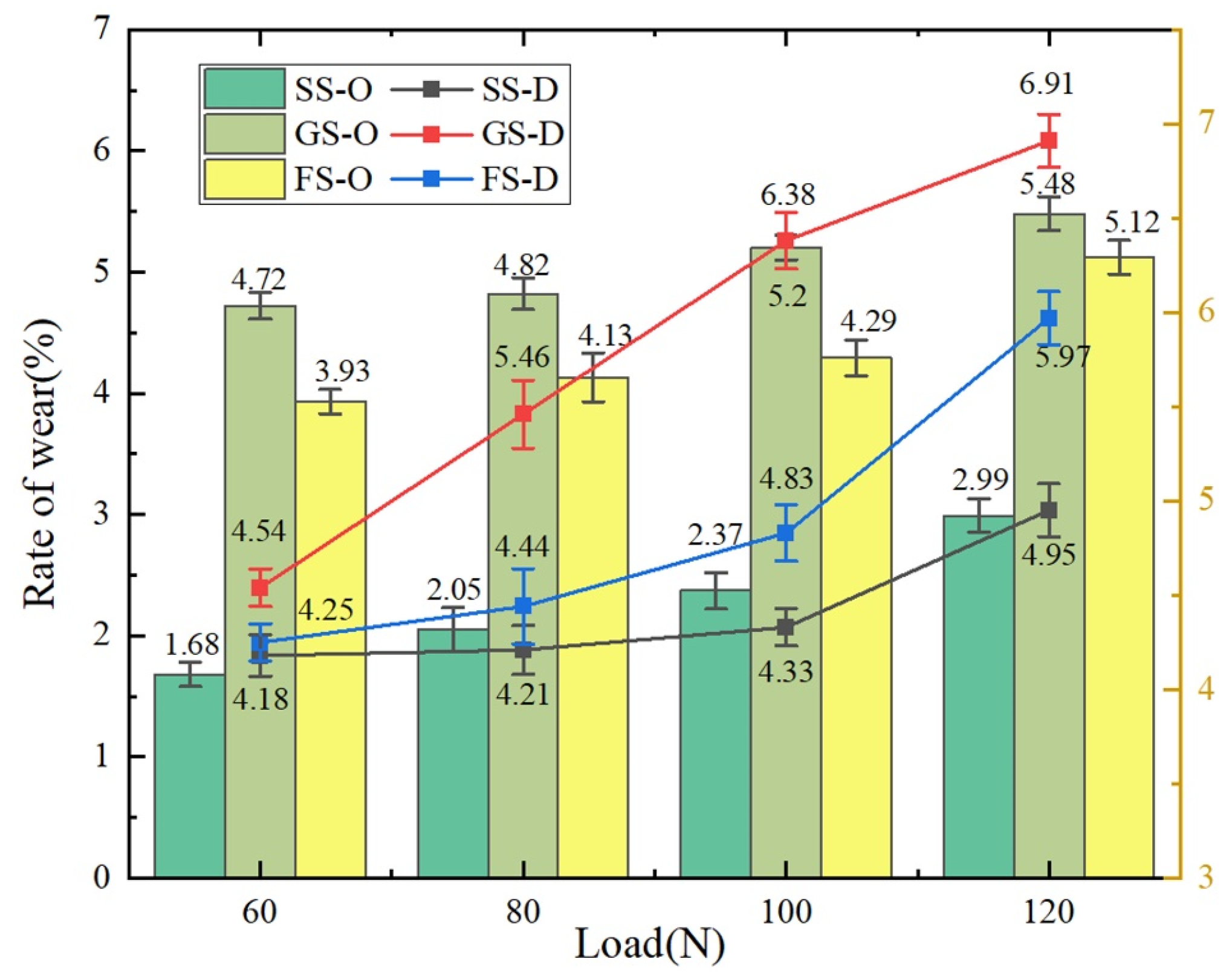Study of the Friction Behavior of Embedded Fibers in YG8 Surface Grooves
Abstract
1. Introduction
2. Experiments and Methods
2.1. Materials Reparation
2.2. Experimental Procedure
3. Results and Discussions
3.1. Tribological Properties of Samples
3.2. Friction Behavior of Samples in Steady Stage
3.3. Wettability Behavior of Lubricants
3.4. Worn Surface Analysis
3.5. Surface Profile Characteristics
3.6. Antifriction Mechanisms of FS
4. Conclusions
- (1)
- The friction coefficient was positively correlated with the load, which was because the load changed the real contact area between the friction pairs. Among them, FS had the lowest friction coefficient in dry/oil environment, showing excellent wear resistance and anti-friction characteristics.
- (2)
- Among SS, GS and FS, GS disrupted the surface continuity with severe tooth jump and FS exhibited the lowest friction coefficient and friction load. The synergistic effect of the lubricant and composite structure significantly decreased the fluctuation of friction force and applied load, where FS exhibited the best anti-friction characteristics at 1 Hz and 120 N.
- (3)
- The adsorption ability of FS to droplets improved the retention and storage of lubricant and promoted the formation of oil film, thus enhancing the friction reduction performance of FS.
- (4)
- The wear mechanism of SS was abrasive wear, the wear mechanism of GS was adhesive wear and the friction mechanism of FS was chemical wear. FS improved the friction performance of the lubricant under chemical wear, repaired surface damage and improved wear resistance.
- (5)
- During the sliding process, the fiber material diffused and migrated at the friction interface, which accelerated the formation of an oxide layer. The FS surface effectively improved the surface morphology of the sample and exhibited excellent tribological performance.
Author Contributions
Funding
Institutional Review Board Statement
Informed Consent Statement
Data Availability Statement
Acknowledgments
Conflicts of Interest
References
- Xu, B.; Feng, T.; Xiao, Y.; Wu, X.; Fu, L.; Zhao, H.; Lei, J.; Zhao, C. Micro-EDM of micro-stepped hole in YG8 cemented carbide by using micro milling cutter. Int. J. Adv. Manuf. Technol. 2022, 121, 1015–1026. [Google Scholar] [CrossRef]
- Li, B.; Rui, Z. Friction and wear behaviours of YG8 sliding against austempered ductile iron under dry, chilled air and minimal quantity lubrication conditions. Adv. Mech. Eng. 2019, 11, 168781401984706. [Google Scholar] [CrossRef]
- Li, G.; Li, J.; Sun, J.; Jiang, F. Study on the tribological properties between the aluminum alloy 7050-T7451 and the YG8 cemented carbide. J. Mater. Sci. 2011, 46, 723–726. [Google Scholar] [CrossRef]
- Deng, J.-X. Wear surface studies on blasting nozzles in abrasive surface treatment. Surf. Eng. 2005, 21, 439–444. [Google Scholar] [CrossRef]
- Huang, L.; Yuan, J.; Li, C.; Hong, D. Microstructure, tribological and cutting performance of Ti-DLC/α-C:H multilayer film on cemented carbide. Surf. Coat. Technol. 2018, 353, 163–170. [Google Scholar] [CrossRef]
- Zhang, N.; Yang, F.; Liu, G. Cutting performance of micro-textured WC/Co tools in the dry cutting of Ti-6Al-4V alloy. Int. J. Adv. Manuf. Technol. 2020, 107, 3967–3979. [Google Scholar] [CrossRef]
- Wang, X.; Popov, V.L.; Yu, Z.; Li, Y.; Xu, J.; Yu, H. Study on cutting performance of SiCp/Al composite using textured YG8 carbide tool. Int. J. Adv. Manuf. Technol. 2022, 119, 2213–2222. [Google Scholar] [CrossRef]
- Arslan, A.; Masjuki, H.H.; Varman, M.; Kalam, M.A.; Quazi, M.M.; Al Mahmud, K.A.H.; Gulzar, M.; Habibullah, M. Effects of texture diameter and depth on the tribological performance of DLC coating under lubricated sliding condition. Appl. Surf. Sci. 2015, 356, 1135–1149. [Google Scholar] [CrossRef]
- Etsion, I. Modeling of surface texturing in hydrodynamic lubrication. Friction 2013, 1, 195–209. [Google Scholar] [CrossRef]
- Bhaduri, D.; Batal, A.; Dimov, S.S.; Zhang, Z.; Dong, H.; Fallqvist, M.; M’Saoubi, R. On Design and Tribological Behaviour of Laser Textured Surfaces. Procedia CIRP 2017, 60, 20–25. [Google Scholar] [CrossRef]
- Ghezzi, I.; Tonazzi, D.; Rovere, M.; Coeur, C.L.; Berthier, Y.; Massi, F. Frictional behaviour of a greased contact under low sliding velocity condition. Tribol. Int. 2021, 155, 106788. [Google Scholar] [CrossRef]
- Gropper, D.; Harvey, T.J.; Wang, L. Numerical analysis and optimization of surface textures for a tilting pad thrust bearing. Tribol. Int. 2018, 124, 134–144. [Google Scholar] [CrossRef]
- Grützmacher, P.G.; Rammacher, S.; Rathmann, D.; Motz, C.; Mücklich, F.; Suarez, S. Interplay between microstructural evolution and tribo-chemistry during dry sliding of metals. Friction 2019, 7, 637–650. [Google Scholar] [CrossRef]
- Huang, Q.; Shi, X.; Xue, Y.; Zhang, K.; Gao, Y.; Wu, C. Synergetic effects of biomimetic microtexture with multi-solid lubricants to improve tribological properties of AISI 4140 steel. Tribol. Int. 2022, 167, 107395. [Google Scholar] [CrossRef]
- Malakizadi, A.; Hajali, T.; Schulz, F.; Cedergren, S.; Ålgårdh, J.; M’Saoubi, R.; Hryha, E.; Krajnik, P. The role of microstructural characteristics of additively manufactured Alloy 718 on tool wear in machining. Int. J. Mach. Tools Manuf. 2021, 171, 103814. [Google Scholar] [CrossRef]
- Yuan, S.; Huang, W.; Wang, X. Orientation effects of micro-grooves on sliding surfaces. Tribol. Int. 2011, 44, 1047–1054. [Google Scholar] [CrossRef]
- Wu, C.; Yang, K.; Ni, J.; Lu, S.; Yao, L.; Li, X. Investigations for vibration and friction torque behaviors of thrust ball bearing with self-driven textured guiding surface. Friction 2023, 11, 894–910. [Google Scholar] [CrossRef]
- Wos, S.; Koszela, W.; Pawlus, P. The effect of graphite surface texturing on the friction reduction in dry contact. Tribol. Int. 2020, 151, 106535. [Google Scholar] [CrossRef]
- Oh, D.-S. Tribological characteristics of micro-ball bearing with V-shaped grooves coated with ultra-thin protective layers. Tribol. Int. 2018, 10, 481–490. [Google Scholar] [CrossRef]
- Kim, W.-Y.; Senguttuvan, S.; Kim, S.H.; Lee, S.W.; Kim, S.-M. Numerical study of flow and thermal characteristics in titanium alloy milling with hybrid nanofluid minimum quantity lubrication and cryogenic nitrogen cooling. Int. J. Heat Mass Transf. 2021, 170, 121005. [Google Scholar] [CrossRef]
- Kong, L.; Zhang, L.; Bao, Y.; Liu, D.; Liu, S. Effect of Surface Roughness and Particle Size on Lubrication Mechanisms of SiO2 Nanoparticles. Adv. Mater. Sci. Eng. 2022, 2022, 7051650. [Google Scholar] [CrossRef]
- Xue, Y.; Shi, X.; Huang, Q.; Zhang, K.; Wu, C. Effects of groove-textured surfaces with Sn-Ag-Cu and MXene-Ti3C2 on tribological performance of CSS-42L bearing steel in solid-liquid composite lubrication system. Tribol. Int. 2021, 161, 107099. [Google Scholar] [CrossRef]
- Tang, W.; Zhou, Y.; Zhu, H.; Yang, H. The effect of surface texturing on reducing the friction and wear of steel under lubricated sliding contact. Appl. Surf. Sci. 2013, 273, 199–204. [Google Scholar] [CrossRef]
- Xiong, S.; Liang, D.; Wu, H.; Lin, W.; Jinshan, C.; Zhang, B. Preparation, characterization, tribological and lubrication performances of Eu doped CaWO4 nanoparticle as anti-wear additive in water-soluble fluid for steel strip during hot rolling. Appl. Surf. Sci. 2021, 539, 148090. [Google Scholar] [CrossRef]
- He, J.; Sun, J.; Meng, Y.; Pei, Y.; Wu, P. Synergistic lubrication effect of Al2O3 and MoS2 nanoparticles confined between iron surfaces: A molecular dynamics study. J. Mater. Sci. 2021, 56, 9227–9241. [Google Scholar] [CrossRef]
- Huang, S.; Lin, W.; Li, X.; Fan, Z.; Wu, H.; Jiang, Z.; Huang, H. Roughness-dependent tribological characteristics of water-based GO suspensions with ZrO2 and TiO2 nanoparticles as additives. Tribol. Int. 2021, 161, 107073. [Google Scholar] [CrossRef]
- Vlădescu, S.-C.; Medina, S.; Olver, A.V.; Pegg, I.G.; Reddyhoff, T. Lubricant film thickness and friction force measurements in a laser surface textured reciprocating line contact simulating the piston ring–liner pairing. Tribol. Int. 2016, 98, 317–329. [Google Scholar] [CrossRef]
- Xiong, D.; Qin, Y.; Li, J.; Wan, Y.; Tyagi, R. Tribological properties of PTFE/laser surface textured stainless steel under starved oil lubrication. Tribol. Int. 2015, 82, 305–310. [Google Scholar] [CrossRef]
- Zhu, G.; Li, H.; Zhang, T.; Liu, M. Modeling and simulation of micro-hole fabrication on brittle material using abrasive air jet machining. J. Manuf. Process. 2021, 72, 361–374. [Google Scholar] [CrossRef]
- Xue, Y.; Wu, C.; Shi, X.; Huang, Q.; Ibrahim, A.M.M. Effects of groove-textured surfaces filled with Sn-Ag-Cu and MXene-Ti3C2 composite lubricants on tribological properties of CSS-42L bearing steel. Friction 2021, 10, 1091–1113. [Google Scholar] [CrossRef]
- Xing, Y.; Deng, J.; Wang, X.; Meng, R. Effect of laser surface textures combined with multi-solid lubricant coatings on the tribological properties of Al2O3/TiC ceramic. Wear 2015, 342–343, 1–12. [Google Scholar] [CrossRef]
- Rapoport, L.; Moshkovich, A.; Perfilyev, V.; Lapsker, I.; Halperin, G.; Itovich, Y.; Etsion, I. Friction and wear of MoS2 films on laser textured steel surfaces. Surf. Coat. Technol. 2008, 202, 3332–3340. [Google Scholar] [CrossRef]
- Gadelmoula, A.; Aldahash, S.A. Tribological Properties of Glass Bead-Filled Polyamide 12 Composite Manufactured by Selective Laser Sintering. Polymers 2023, 15, 1268. [Google Scholar] [CrossRef] [PubMed]
- Pettersson, U.; Jacobson, S. Influence of surface texture on boundary lubricated sliding contacts. Tribol. Int. 2003, 36, 857–864. [Google Scholar] [CrossRef]
- Pei, H.-W.; Liu, H.; Zhu, Y.-L.; Lu, Z.-Y. Understanding the wettability of a hairy surface: Effect of hair rigidity and topology. Phys. Chem. Chem. Phys. 2016, 18, 18767–18775. [Google Scholar] [CrossRef]
- Wenzel, R.N. Resistance of solid surfaces to wetting by water. Ind. Eng. Chem. 1936, 28, 988–994. [Google Scholar] [CrossRef]










| Density (g/cm3) | Melting Point | Molding Shrinkage (%) | Tensile Strength (Pa) |
|---|---|---|---|
| 1.14 | 260 | 0.8–1.5 | 800 |
| Composition (wt.%) | Density (g/cm3) | Impact Energy (J/cm2) | Hardness (HRA) | Bending Strength (MPa) | |
|---|---|---|---|---|---|
| WC | Co | ||||
| 92 | 8 | 14.6–14.9 | 2.5 | 89 | 1500 |
| Laser Wavelength (nm) | Pulse Frequency (kHz) | Average Power (W) | Pulse Width (fs) | Number of Scans |
|---|---|---|---|---|
| 800 | 5–10 | 4 | 100 | 200 |
| Samples | Surfaces | Width (w/µm) | Pitch (d/µm) | Depth (h/µm) |
|---|---|---|---|---|
| SS | Smooth surfaces | … | … | … |
| GS | Textured surfaces (Grooves) | 200 | 1000 | 300 |
| FS | Flocking surfaces (Grooves + Nylon) | 200 | 1000 | 300 |
| Voltage (V) | Time (s) | Distance (mm) | Fiber Length (mm) | Fiber Diameter (nm) |
|---|---|---|---|---|
| 120 | 600 | 30 | 0.4 | 67 ± 18 |
| Samples | SS | GS | FS | |||||||||
|---|---|---|---|---|---|---|---|---|---|---|---|---|
| Lubrication | No | |||||||||||
| Load (N) | 60 | 80 | 100 | 120 | 60 | 80 | 100 | 120 | 60 | 80 | 100 | 120 |
| Lubrication | Castor oil | |||||||||||
| Load (N) | 60 | 80 | 100 | 120 | 60 | 80 | 100 | 120 | 60 | 80 | 100 | 120 |
| Reciprocating Displacement (mm) | Test Time (s) | Test Temperature | Ambient Humidity (%) |
|---|---|---|---|
| 4.15 | 1200 | 23 ± 2 | 50 ± 5 |
Disclaimer/Publisher’s Note: The statements, opinions and data contained in all publications are solely those of the individual author(s) and contributor(s) and not of MDPI and/or the editor(s). MDPI and/or the editor(s) disclaim responsibility for any injury to people or property resulting from any ideas, methods, instructions or products referred to in the content. |
© 2023 by the authors. Licensee MDPI, Basel, Switzerland. This article is an open access article distributed under the terms and conditions of the Creative Commons Attribution (CC BY) license (https://creativecommons.org/licenses/by/4.0/).
Share and Cite
Huang, Z.; Zhang, H.; Ni, J.; Yang, L.; Feng, K. Study of the Friction Behavior of Embedded Fibers in YG8 Surface Grooves. Materials 2023, 16, 5074. https://doi.org/10.3390/ma16145074
Huang Z, Zhang H, Ni J, Yang L, Feng K. Study of the Friction Behavior of Embedded Fibers in YG8 Surface Grooves. Materials. 2023; 16(14):5074. https://doi.org/10.3390/ma16145074
Chicago/Turabian StyleHuang, Zhiping, Haohan Zhang, Jing Ni, Lingqi Yang, and Kai Feng. 2023. "Study of the Friction Behavior of Embedded Fibers in YG8 Surface Grooves" Materials 16, no. 14: 5074. https://doi.org/10.3390/ma16145074
APA StyleHuang, Z., Zhang, H., Ni, J., Yang, L., & Feng, K. (2023). Study of the Friction Behavior of Embedded Fibers in YG8 Surface Grooves. Materials, 16(14), 5074. https://doi.org/10.3390/ma16145074






